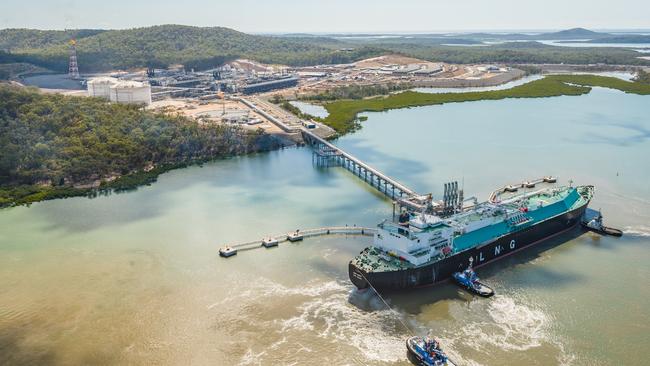Santos-controlled Gladstone LNG project seeks gas ‘trigger’ reform
The Santos Gladstone LNG project wants a key clause in the gas export trigger arrangements removed amid fears it would be held solely responsible for topping up local supplies.

The Santos-controlled Gladstone LNG project wants a key clause in the gas export trigger arrangements to be removed amid fears the venture would be held solely responsible among exporters for topping up local supplies to avert a east coast gas shortage.
The federal government is urgently reviewing the Australian Domestic Gas Security Mechanism amid a national energy crisis sparked in part by a squeeze on gas supplies for users.
The existing mechanism, known as the gas trigger, can force big LNG exporters to divert supplies from their Queensland plants to domestic users if a local shortfall is declared.
The GLNG venture is the only project drawing gas from the domestic market, placing it in net deficit and meaning Santos and its partners – Malaysia’s Petronas, France’s Total and South Korea’s Kogas – would have to shoulder the shortfall burden by themselves, given they fail to meet the “net contributor” test.
Sources said GLNG had told an official review that the net contributor component of the gas trigger should be abolished, given it would only apply to its venture and failed to take into account that its gas had already been contracted to international buyers. GLNG declined to comment.
Origin Energy’s APLNG and Shell’s QCLNG are both net contributors to the local market, data seen by The Australian shows, which means GLNG faces having to divert contracted exports to Asian buyers to the domestic market if the ADGSM is triggered.
GLNG has privately argued that all three projects should jointly make up any shortfall if the mechanism is triggered, noting its competitors are free to sell surplus LNG cargoes on the lucrative Asian spot market, whereas all of its gas is fully contracted.
The big three LNG producers have been in the spotlight amid concerns from the federal government that too much gas may be heading offshore to overseas buyers, exacerbating a domestic energy crunch in states such as Victoria, which face shortages through the rest of winter.
the market operator has called on Queensland LNG exporters to funnel supplies south to Victoria as the Andrews government faces gas shortages until the end of September. An emergency supply guarantee mechanism was invoked last week, for just the second time since it was introduced in 2017, raising pressure on producers, including GLNG.
The Albanese government faces a difficult exercise juggling the net contributor issue, according to Credit Suisse, which notes the Queensland producers face regulatory intervention despite the gas crisis being caused by a string of broader failures in the electricity market, including coal breakdowns. “Arguments in favour of leaving the net contributor test within the policy include that QCLNG and APLNG already voluntarily sell gas domestically, so the policy only needs to target GLNG where voluntary diversions remain more intractable at a joint venture level, and that QCLNG and APLNG have shouldered nearly all of the burden of supplying additional domestic gas over the last five or so years,” Credit Suisse analyst Saul Kavonic said.
“We expect the government is also acutely aware that the GLNG project partners originally took a final investment decision with full knowledge they did not have enough gas to fill their LNG plant and it could put upward pressure on domestic gas prices, all those years ago.”
Resources Minister Madeleine King may ultimately choose to share the potential shortfall pain across all three ventures, the broker said. It noted an additional 5 per cent of Queensland exports would need to be diverted, a modest burden if spread across projects, but much more material if applied just to GLNG.
“Arguments in favour of adjusting or removing the net contributor test include that GLNG has already chosen to reduce exports to minimum contract levels, restricting GLNG exports could violate contract commitments, and that QCLNG and APLNG have more flexibility and spot volumes to aid the market than GLNG does,” Mr Kavonic said. “Overall, we expect the government will be looking for the domestic gas policy burden on Qld LNG projects to be shared, unlike the prevailing situation.”
The trio of Queensland exporters shipped record volumes of 24 million tonnes of LNG in 2021-22, beating the prior year‘s record of 23.3 million tonnes.
The ADGSM was due to expire at the end of 2022 but Ms King announced earlier in July it would be extended to 2030 to “help secure ongoing gas supplies to the next decade”.
A separate review of the gas trigger is also under way given questions about its effectiveness and how quickly it can be deployed to fix domestic shortfalls.
A price trigger may also be on the table. The Australian Chamber of Commerce & Industry is calling for its inclusion and for the ADGSM to be triggered immediately to offer relief for domestic gas customers.
“The ADGSM must ensure certainty of both supply and prices to households and commercial and industrial gas users,” the ACCI said in a submission. “Therefore, in addition to the gas supply trigger, the ADGSM should also have a price trigger to ensure gas users are not exposed to exorbitantly high gas prices. It should also ensure domestic customers, particularly commercial and industrial users, have access to short and long-term supply contracts, on reasonable terms and at affordable prices.”
Big aluminium users said a trigger that could be applied immediately was needed.





To join the conversation, please log in. Don't have an account? Register
Join the conversation, you are commenting as Logout